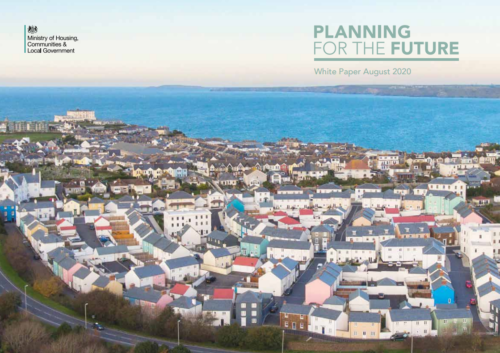The Government has published their highly anticipated white paper: Planning for the Future, which introduces the greatest planning reforms since the Town and Country Planning Act 1947.
The paper seeks to overhaul the planning system with dramatic changes to land designations, planning policy, timescales, planning obligations and more – all of which is centred around an ambition to streamline the planning process by harnessing the latest technology to bring the English planning system into the 21st Century.
Planning for the Future is a consultation paper which seeks input on a series of landmark proposals. In broad terms, the reforms will:
- Enable public access to online planning maps and data.
- Protect valued green spaces by promoting more building on brownfield land and requiring all new streets to be tree lined.
- Quicken housing delivery by streamlining the preparation of local housing plans from 7 years to 30 months.
- Ensure every area has a local plan in place.
- Overhaul and replace the planning process with a clearer, rules-based system.
- Introduce a single, simple national levy to replace the developer contributions (including affordable housing provision) and the Community Infrastructure Levy.
- Create a fast-track system for beautiful buildings and establish local design guidance for developers to build and preserve beautiful communities.
- Require that all new homes be ‘zero carbon ready’, with no need to be retrofitted to achieve net zero carbon emissions by 2050.
The 12-week consultation period runs from 6th August to the 28th October.
These reforms will be achieved through 23 proposals, some of the key proposals include:
New Land Categories: England will be categorised into three area types which will determine the scale of achievable development:
- Growth areas: Land suitable for substantial development. Such areas will include new settlements, urban extension sites and brownfield land. Growth areas would benefit from outline approval for the principle of development. Areas subject to important planning constraints would be excluded from Growth Areas (for example, areas of flood risk).
- Renewal areas: Land suitable for development including previously developed land, town centres, residential areas and rural areas within or on the edge of villages (that are not designated as Growth or Protected areas) where smaller scale development is appropriate. Renewal areas would benefit from a presumption in favour of sustainable development for appropriate uses.
- Protected areas: Land subject to more stringent development controls. Such land includes areas subject to important planning constraints such as Green Belt land, Areas of Outstanding Natural Beauty, Conservation Areas, Local Wildlife Sites and areas of significant flood risk, in addition to some areas of open countryside (that are not designated as Growth or Protected areas).
It should be noted that area types would be defined at both local and national scales and all areas would be annotated on Local Plan maps to signpost what development is appropriate and where.
Streamlining Local Plans: General development management policies will be removed from Local Plans and applied at a national scale to reduce duplication. It is envisioned that plans will be reduced by as much as two-thirds.
The role of Local Plans will be to set out clear rules and identify site-specific requirements. Plans are to become more visual, map-based documents with core standards and development requirements (rather than long lists of policies).
Introducing Design Codes: Local Plans will be accompanied by locally produced design codes and it is also proposed that each local authority have a chief officer for design and place-making.
Fast-tracking Beauty: Introducing a fast-track process to accelerate high-quality development (which reflects local character and preferences) through the planning process.
Speeding Up the Process: Local authorities and the Planning Inspectorate will be required to comply with a statutory timetable. Failure to do so will result in sanctions. The timescales of Local Plans are to be dramatically reduced and there is a commitment to achieve faster, more certain decision-making in accordance with firm deadlines.
New Standard Method for Housing Supply: There will be a new method for establishing housing requirement to ensure that land is being released to address affordability and remove barriers to housing delivery. The housing requirement would factor in land constraints and opportunities to more effectively use land – including through densification.
Streamlining but Widening Consultation: Local authorities should re-invent their public consultation process to reduce the capacity of minority voices to shape planning outcomes while encouraging more views from a wider range of people to be heard. Neighbourhood Plans will also be retained as important means of community input.
Introducing the Infrastructure Levy: Reforming planning obligations and the Community Infrastructure Levy into a single Infrastructure Levy, charged as a fixed proportion of development value above a yet to be confirmed threshold. The levy would be set nationally and aims to deliver a higher proportion of affordable housing provision.
The new levy would cover affordable housing provision with a view to enable local authorities to drive up on-site affordable housing.
Getting ‘Zero Carbon Ready’: The Government will facilitate improvements in the energy efficiency standards for buildings to help achieve net-zero carbon development by 2050.
Edgars have begun the process of thoroughly reviewing these proposals and welcome the opportunity to represent the interests of our clients and provide our planning expertise as part of our consultation response.
The consultation document is available at: https://www.gov.uk/government/consultations/planning-for-the-future
Back to news
